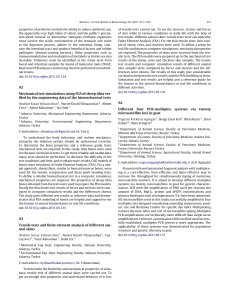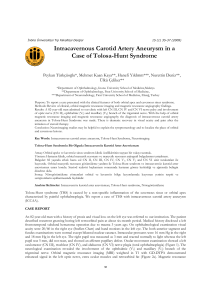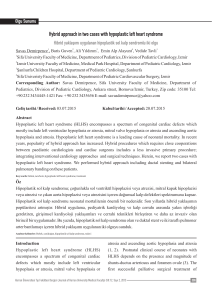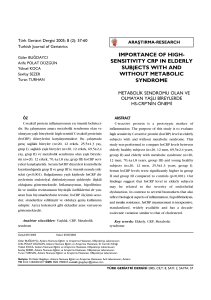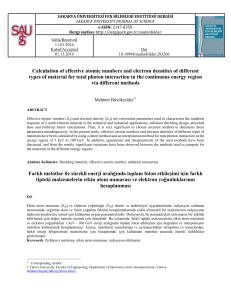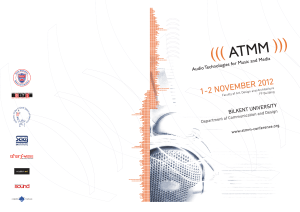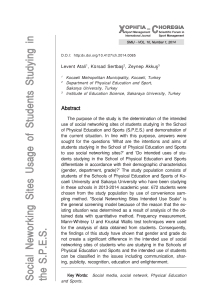Brainstem Involvement in a Patient With Fahr`s Syndrome
advertisement
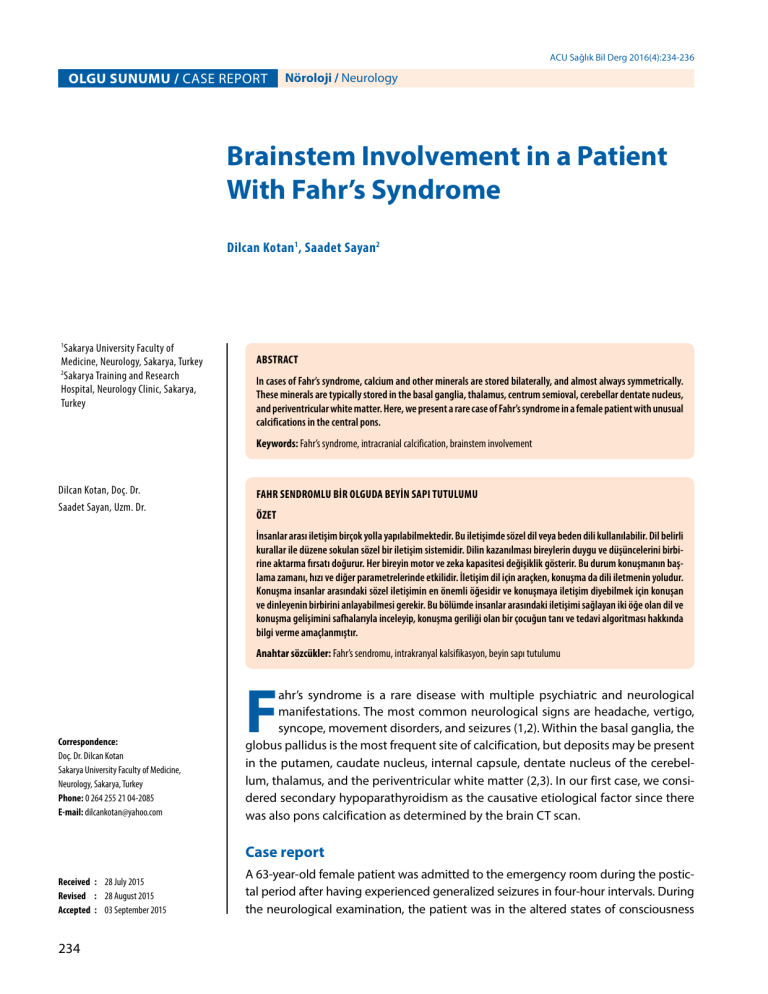
ACU Sağlık Bil Derg 2016(4):234-236 OLGU SUNUMU / CASE REPORT Nöroloji / Neurology Brainstem Involvement in a Patient With Fahr’s Syndrome Dilcan Kotan1, Saadet Sayan2 1 Sakarya University Faculty of Medicine, Neurology, Sakarya, Turkey 2 Sakarya Training and Research Hospital, Neurology Clinic, Sakarya, Turkey ABSTRACT In cases of Fahr’s syndrome, calcium and other minerals are stored bilaterally, and almost always symmetrically. These minerals are typically stored in the basal ganglia, thalamus, centrum semioval, cerebellar dentate nucleus, and periventricular white matter. Here, we present a rare case of Fahr’s syndrome in a female patient with unusual calcifications in the central pons. Keywords: Fahr’s syndrome, intracranial calcification, brainstem involvement Dilcan Kotan, Doç. Dr. Saadet Sayan, Uzm. Dr. FAHR SENDROMLU BİR OLGUDA BEYİN SAPI TUTULUMU ÖZET İnsanlar arası iletişim birçok yolla yapılabilmektedir. Bu iletişimde sözel dil veya beden dili kullanılabilir. Dil belirli kurallar ile düzene sokulan sözel bir iletişim sistemidir. Dilin kazanılması bireylerin duygu ve düşüncelerini birbirine aktarma fırsatı doğurur. Her bireyin motor ve zeka kapasitesi değişiklik gösterir. Bu durum konuşmanın başlama zamanı, hızı ve diğer parametrelerinde etkilidir. İletişim dil için araçken, konuşma da dili iletmenin yoludur. Konuşma insanlar arasındaki sözel iletişimin en önemli öğesidir ve konuşmaya iletişim diyebilmek için konuşan ve dinleyenin birbirini anlayabilmesi gerekir. Bu bölümde insanlar arasındaki iletişimi sağlayan iki öğe olan dil ve konuşma gelişimini safhalarıyla inceleyip, konuşma geriliği olan bir çocuğun tanı ve tedavi algoritması hakkında bilgi verme amaçlanmıştır. Anahtar sözcükler: Fahr’s sendromu, intrakranyal kalsifikasyon, beyin sapı tutulumu Correspondence: Doç. Dr. Dilcan Kotan Sakarya University Faculty of Medicine, Neurology, Sakarya, Turkey Phone: 0 264 255 21 04-2085 E-mail: [email protected] F ahr’s syndrome is a rare disease with multiple psychiatric and neurological manifestations. The most common neurological signs are headache, vertigo, syncope, movement disorders, and seizures (1,2). Within the basal ganglia, the globus pallidus is the most frequent site of calcification, but deposits may be present in the putamen, caudate nucleus, internal capsule, dentate nucleus of the cerebellum, thalamus, and the periventricular white matter (2,3). In our first case, we considered secondary hypoparathyroidism as the causative etiological factor since there was also pons calcification as determined by the brain CT scan. Case report Received : 28 July 2015 Revised : 28 August 2015 Accepted : 03 September 2015 234 A 63-year-old female patient was admitted to the emergency room during the postictal period after having experienced generalized seizures in four-hour intervals. During the neurological examination, the patient was in the altered states of consciousness Kotan D and Sayan S A B C Figure 1. Computed tomography showing calcification in the bilateral basal ganglia, thalamus, periventricular white matter (A), cerebellar dentate nucleus (B), and pons (C). associated with postictal periods, so cooperation was difficult. An examination performed two hours later showed that the pupil responses were bilaterally nonreactive due to a cataract surgery. Moreover, bilateral hand tremor, bradykinesia, associated loss of movement, and anteflexion posture were observed. She had no motor weaknesses or cranial nerve involvement, and the results of the other systemic examinations were normal. A brain computed tomography (CT) scan showed calcification in the bilateral basal ganglia, thalamus, periventricular white matter, cerebellar dentate nucleus, and pons (Figure 1a,b,c). Laboratory investigations including whole blood count, urine analysis, sedimentation rate, fasting blood glucose, thyroid hormones, blood serum iron, ferritin, and total iron binding capacity, showed no abnormalities. The laboratory results, within the normal (N) range, were as follows: serum total calcium level, 5.1 mg/dL (N: 8.8−10.2); phosphorus, 4.9 mg/ dL (N: 2.5−4.5); parathormone, 0.1 pg/ml (N: 15−68); and vitamin D, also within the normal range. Calcium ion levels were immediately restored in the emergency room while being monitored. A thyroid ultrasound was normal. The patient was diagnosed with Fahr’s syndrome secondary to hypoparathyroidism. The patient had no electroencephalogram (EEG) abnormalities. The patient was started on treatments with levodopa, and received regular follow-up care through outpatient services. Discussion Fahr’s syndrome is associated with a variety of other diseases but no specific etiologic agent has been identified yet. Suggested possible causes for this disorder include calcium metabolism, inflammatory, and vascular disorders. Other possible causes include tumoral conditions, encephalitis, systemic diseases, anoxia, radiation, genetic disorders, and various toxins (2,4). Our case was related to a parathormone metabolism disorder. Etiology was not directly correlated with image calcification patterns. Fahr’s syndrome rarely presents during childhood or adolescence, and the usual age of presentation is during the fourth to sixth decades of life (2). Our case was in her seventh decade and based on the clinico-radiological and biochemical findings, the diagnosis of Fahr’s syndrome due to secondary hypoparathyroidism was strongly indicative (6). Several bilateral symmetrical calcifications of the basal ganglia, thalamus, periventricular white matter, and cerebellar nuclei have been described following Fahr’s original description in 1930. CT scanning is an easy test with maximum sensitivity, and allows the easy diagnosis of Fahr’s syndrome (3,4). Pontine calcification has rarely been reported in the literature; moreover, the reasons for focal calcium accumulations in the pons are currently unknown (3). According to the radiological findings, our case was the first described in which the pons involvement to be secondary to hypoparathyroidism. The treatment for Fahr’s syndrome was directed at the identified cause, particularly the hypoparathyroidism. In other cases, symptomatic or conservative therapy with clinical observation is the rule. The prognosis is variable and difficult to predict. Our case was medicated and followed in terms of Parkinsonism and secondary hypoparathyroidism. In patients with Fahr’s syndrome, calcifications in non-classical residential areas, such as the midline of the brainstem, had been reported only twice in literature (3,7). The current case was presented to draw attention to this rare localization and to contribute to the literature. ACU Sağlık Bil Derg 2016(4):234-236 235 Fahr’s Syndrome References 1. Cartier L, Passig C, Gormaz A, López J. Neuropsychological and neurophysiological features of Fahr’s disease. Rev Med Chil. 2002;130:1383-90. 4. Kotan D, Aygul R. Familial Fahr’s disease in a Turkish family. South Med J. 2009;102:85-6. 5. Manyam BV. What is and what is not ‘Fahr’s disease’. Parkinsonism Relat Disord. 2005;11:73-80. 2. Gupta SK, Gandotra D, Singh K, Sharma R, Sharma A. Fahr’s syndrome. JK Science. 2007;9:215. 6. Kowdley KV, Coul BM, Orwall ES. Cognitive impairment and intracranial calcification in chronic hypoparathyroidism. Am J Med Sci. 1999;317:273-7. 3. Rajul Rastogi, AK Singh, UC Rastog, Chander Mohan, Vaibhav Rastogi. Fahr’s syndrome: a rare clinico-radiologic entity. MJAFI. 2011;67:159-61 7. Cartier L, Passig C, Gormaz A, López J. Neuropsychological and neurophysiological features of Fahr’s disease. Rev Med Chil. 2002;130:1383-90. 236 ACU Sağlık Bil Derg 2016(4):234-236
